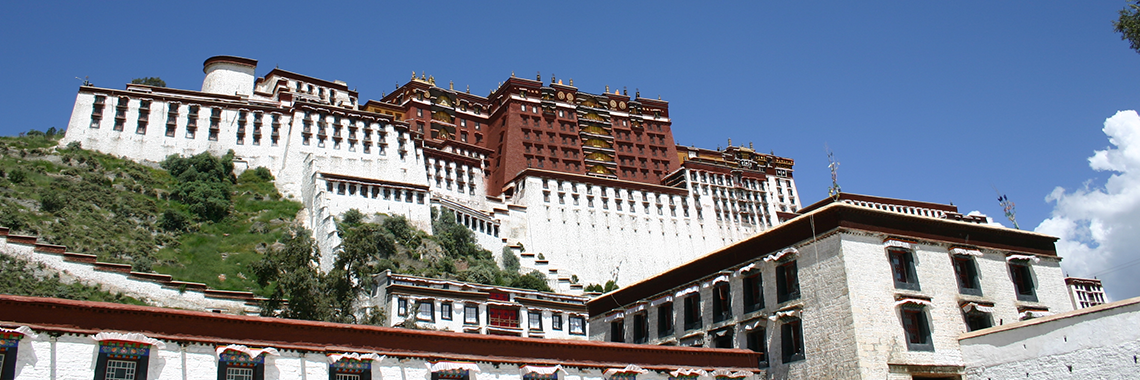
Facts
Activity
Contact Us
Nepal
Hike Himalaya Adventure Pvt. Ltd.
GPO: 6062, Thamel, Kathmandu, Nepal
Tel: +977 1 4432044, 4432011/
Fax: +977 1 4432044
Hunting Line:
+977 9851140893, 9843293581
e: info@hikehimalayaadventure.com
Australia and New Zeland
Matthew Eakin
8 illamatta way, Orange, NSW-2800
e:matt@hikehimalayaadventure.com
Cell: +61 402 289 226
In Europe
Tatiana De Wée
Jozef Smeetslaan 92
3630 Maasmechelen
Cell: +32 (0)498200651
e:tatiana@hikehimalayaadventure.com
History and Geography
History
Shamanism was the predominant religion before the introduction of Buddhism in the 7th century. Buddhist missionaries from India came to Tibet and started an alphabet system for the Tibetan language and started translations of Buddhist texts. During this time Tibet was a strong kingdom but by the 10th century, things began to fall apart with Tibet separating into several principalities. In 1206, Genghis Khan included Tibet in his empire and in the mid-1600's, the Mongols allowed the Dalai Lama to have political power within Tibet. This was done after he was named the head of the Gelugpa sect of Tibetan Buddhism in the 15th century.
China came to control Tibet in the 18th century, but they didn't maintain their authority for many years. In 1911, Tibetan's rebelled and started asserting their authority and independence by trying to get rid of China's officials and military stationed in Tibet. This was completed by 1913, but a meeting was held with Britain, China and Tibet to come to an agreement regarding Tibet's borders and their status as an independent region. China never came to an agreement and the situation became tense finally culminating in battle in eastern Tibet in 1918. The British attempted to settle the dispute with a truce, but they were largely unsuccessful.
Qamdo (Chamdo) was invaded by Communist Troops not more than a year after their control of mainland China. This occurred in October 1950, and by May 1951 the Tibetan government conceded to the Chinese and gave up their independence. They signed a treaty that gave the Dalai Lama (who was 15 at the time) domestic power, but any affairs related to foreign matters or the military was to be deferred to the Chinese government. Improvements were made to communications in Tibet, as well as improving transportation - military highways and airfields were built in a number of areas in the region.
Thing began heating up around 1956, when a committee was established to plan for Tibet's constitution as an autonomous region of China. This caused some rebellions in Sichuan province against the Chinese by ethnic Tibetans. The Dalai Lama was in India at the time and threatened to stay away from Tibet. When the Chinese government halted the process of transferring Tibet into a socialist region, the Dalai Lama returned, even though the eastern rebellion hadn't been stopped. Things didn't improve, especially with the US's CIA (Central Intelligence Agency) involvement. By 1959, with the CIA's help, the rebellion escalated into a revolt in Lhasa that lasted until 1971. Although it lasted over 10 years, after 1959 it wasn't really considered to be a threat by the Chinese, just an annoyance. During this time the Dalai Lama went back to India, and the acting head of the region became the Panchen Lama. Tibetans fled the region in the tens of thousands, with most going to India and others going to Nepal and Bhutan. Tibet formally became an autonomous region of China in 1965 and was reorganized to become a socialist region.
The Panchen Lama was released from jail in 1978, after serving 14 years for criticizing China's rule over Tibet, and was put back in his former position. Surprisingly, the Chinese government agreed that Tibet hadn't been managed well and stated they would be making reforms. Tibetans weren't satisfied with the reforms and showed their distaste by giving violent protests in 1987. Negotiations failed in 1988 to resolve the conflict when the Dalai Lama wouldn't renounce the independence of Tibet and China wouldn't budge on giving Tibet more autonomy.
1993 brought about more demonstrations with the addition of terrorism and in 1995 things escalated with the selection of a new Panchen Lama. The Tibetans sent their selections to the Dalai Lama in India, who selected a boy named Gedhun Choekyi Nyima, a six-year old. Not pleased with their authority being overlooked, the Chinese came up with their own candidate another six-year old by the name of Gyaincain Norbu. Gedhun Choekyi Nyima was held in detention with his family and in 1996 they came down on Tibetan monasteries, which caused the injury and death of some monks. The drama ended in late 1996 with the government putting the Panchen Lama leader in prison.
Geography
Geographically, Tibet can be divided into three major parts, the east, north and south. The eastern part is forest region, occupying approximately one-fourth of the land. Virgin forests run the entire width and length of this part of Tibet.
The northern part is open grassland, where nomads and yak and sheep dwell here. This part occupies approximately half of Tibet.
The southern and central part is agricultural region, occupying about one-fourth of Tibet's land area with all major Tibetan cities and towns such as Lhasa, Shigatse, Gyantse ad Tsetang located in this area, it is considered the cultural center of Tibet.
The total area of the Tibet Autonomous Region is 1,200,000 square kilometers and its population is 1,890,000. The region is administratively divided into one municipality and six prefectures. The municipality is Lhasa, while the six prefectures are Shigatse, Ngari, Lhaoka, Chamdo, Nakchu and Nyingtri(kongpo). The People's Government of the Tibet Autonomous Region exercises the highest administrative authority in Tibet.
